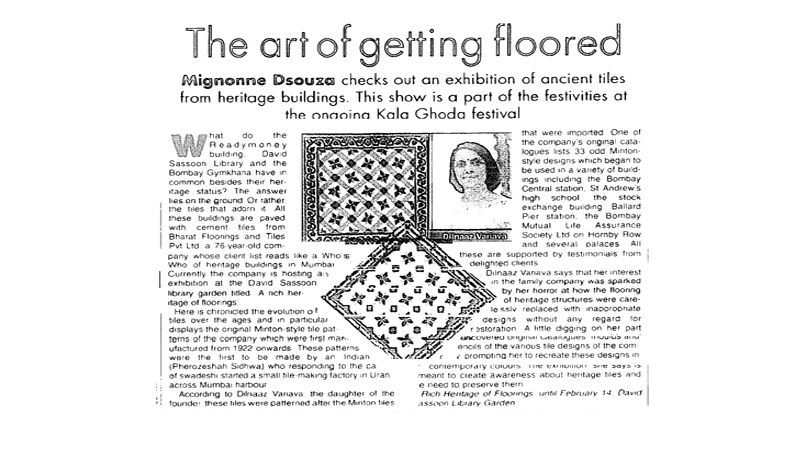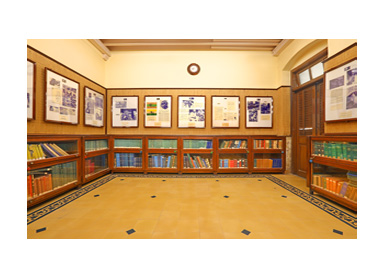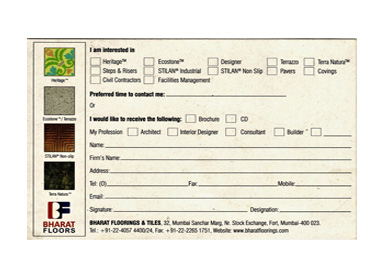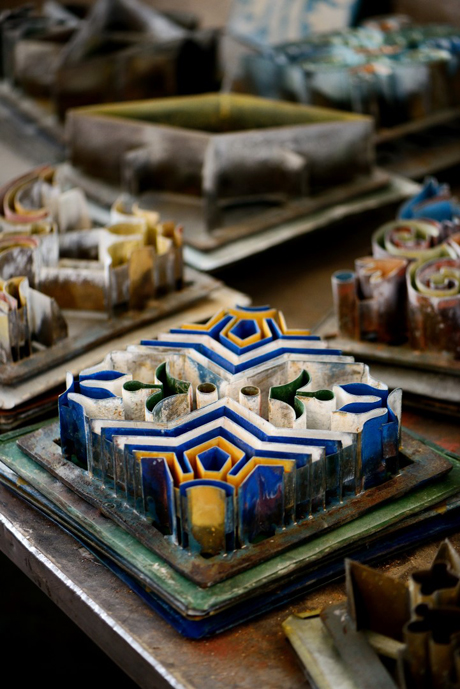100 Years
100 Stories


If an organisation lives to the age of 100 years it will have had to weather a number of crises successfully ! For The Bharat Flooring Tiles Company the first was in 1939-40 when, as a result of WW II, it had to face the crisis of no cement for non defence purposes. But that is another story . Bharat revived after the war, and found that the desire for the elaborate handcrafted designs of the Raj period was almost entirely replaced by the new Art Deco trend for coloured cement tiles with marble or stone chips called ‘mosaic’ or ‘terrazzo’ tiles. Bharat changed with the times and the Art Deco period saw Bharat’s in situ and tiled floorings in almost all the buildings of the Oval, Marine Drive, Malabar Hill – in fact all over the city and across the country. With the help of its design department, mosaic tiles were laid out in unique patterns created for each building. But this boom was followed again by a long dark period!
In the 1960s and early ’70s two major changes occurred in Bharat’s main market, Bombay. No longer were people building their own bungalows and looking for lasting quality. High rise buildings were springing up on vacant plots and where beautiful old bungalows had once stood. Except for a few high rises built for a single corporate, most developers were not concerned with quality. They wanted to lower their costs to increase their profits. Mosaic tiles were no longer laid out in unique patterns as in the art deco bungalows, but were of uniform design for all the flats – in grey or cream or white with chips – with marble or granite where an ‘elegant air’ had to be provided. This new trend had spawned dozens of competitors for Bharat. They reduced the quality of ingredients and processes to compete on prices, giving mosaic tiles a shabby reputation. Bharat refused to compromise on quality and therefore lost its market share. Losses mounted. Ironically, when cheap ceramic tiles arrived from China, many of the cheap cement tile manufacturers were themselves wiped out. Bharat survived only because it had converted some of its factory sheds to warehouses.
Attempts at reviving Bharat to its former glory with the introduction of Stilan® heavy duty factory floorings was thwarted by the closure of the textile mills and the moving out of industries from the high value real estate of the metropolis. By the 1990s Bharat’s financial condition had become dire as the losses of the tile business were wiping out the company’s warehousing income. The family decided to close down the tile business, which had by then made losses for almost 30 years, and sell the warehousing business along with the properties at Kurla and Sewri. Dilnavaz Variava, the Director who had been looking after the warehousing business, was entrusted with this task. Dilnavaz was not keen to close the iconic tile business and it was agreed to hive it off into a new company: Bharat Floorings & Tiles. Destiny, in response to desire, also had a role to play. As she walked through the Kurla factory in 1998 to clear it of clutter before the sale, in a room next to the living quarters of the Factory Manager, Dilnavaz was astonished to find some beautiful brass objects She recalls “I just happened upon them and asked the factory manager, What are these beautiful brass things?” He explained that these are the original Italian stencils for the hand crafted and highly ornamental tiles made in the pre war years at the Mora Uran factory. None of the present factory people had ever used them, but they knew that once upon a time Bharat used to make tiles from them, and upto 300 women would fill in the colours by hand !” She thought it would be wonderful to make such tiles again – and serendipitously the perfect opportunity was waiting for her just around the corner
In the history of every organisation, there will come a time to make certain choices and its future rests upon the course of action taken on the basis of those choices. Bharat’s display at the Kalaghoda Art festival in 1999 and its revival post that, is a testimony to this theory. The Kala Ghoda (KG) Arts Festival is an annual 9 days long festival, which started in February 1999. The exhibition is a fiesta for artists, designers and art enthusiasts who put out new ideas that may shape the art world in the coming years. The first KG Festival aimed, apart from displaying art, to restore the buildings and the ambience of the Kala Ghoda precinct. The KG Festival was to start soon after the discovery of the original stencils and was to play its part in the revival of Bharat Floorings & Tiles and the city’s flooring history.
Dilnavaz was a Vice President of the Bombay Natural History Society’ and was asked to represent it on the first Kala Ghoda Festival committee to help with the conservation of the trees in the Kala Ghoda precinct. She realised, during meetings, that the conservation of the architectural heritage of the precinct was largely focussed on the facades of buildings. She urged that this should expand to conserving all elements of these magnificent buildings – including the flooring. She explained that floors were among the most lasting decorative elements of a building and gave a good idea of its ambience in the period of its construction, but was now often ripped out by interior designers. She says “I suggested that I would try and create an exhibition about what the flooring used to be like at the time of construction of the KG precinct buildings. Though I partly had the business opportunity from recreating them in mind, I was also concerned that people were pulling out these beautiful floors, not realising this is a form of floor art and I wanted them to value and preserve them! The Committee agreed to it.” The stage was now set.
The challenges for the exhibition were numerous and Bharat’s team did not have answers to the questions posed by this new yet exciting task. No one in Bharat had seen how these newly found stencils were used and the techniques of making tiles from them. Dilnavaz had found the original design book that contained the designs and selected a few of the most iconic stencils for recreating them. Firdaus Variava, Dilnavaz’s son recalls that his mother handed over the task to Rumi, an old time factory supervisor ,"She gave it as a project to Rumi and told him, ‘Can you make it again?’ He said, ‘Yeah, I’ll try.” It took a lot of trial and error. He was sending samples and the lines were all squiggly and the colours were bleeding all over the place. It was a real mess in the beginning. We must have made hundreds of samples for the exhibition and out of that we must have found, maybe five of them were actually worth putting on display. The rest of them were horrible – the lines were here-there, and the colours were where they shouldn’t be !” .
Yet after all these trials and errors the Bharat tiles were displayed at the KG Arts Festival. . Along with the physical display of tiles and moulds, Dilnavaz researched and displayed to the audience the history and evolution of flooring, starting with the Minton and China mosaic floorings and arriving finally at the various genres of Bharat’s cement tiles. Dilnavaz and current CEO Faiyaz Mukhtiar attended the exhibition the entire day. They interacted with architects who came to the stalls, fascinated at seeing actual moulds and tiles that constituted the floors of these beautiful old buildings.
Although at the time Dilnavaz wanted to just exhibit Bharat’s legacy and convey what the brand name of Bharat stood for, soon what she had imagined this exhibition might achieve started becoming a reality: Bharat’s revival. The tiles were a super hit and their display had created a buzz about these unique tiles! Although these tiles were in fashion upto 1935, by 1999 people certainly had forgotten about them. Some of the visitors were overwhelmed with nostalgia for their old homes and their beautiful floorings.
At and after the exhibition, some of Bharat’s old clients started calling them and asking if Bharat could make such floors for them. This created another challenge for Dilnavaz and her team. Even though they had managed to pull together enough tiles for the exhibition, doing entire floors was a daunting task. But Mr. Rumi and the factory team plunged into the process of resuscitating the tiles. He started making different samples at the factory. But this did not mark the end of Bharat’s problems! The labour that had become so accustomed to making simple mosaic tiles, were unwilling or unable to adapt to the method of making these handcrafted tiles. The reason was simple: It took a tremendous amount of patience to make these tiles and the existing labour was used to making 500 tiles an hour whereas now they could hardly make 5 or 6 tiles in an hour. After a painful process, Bharat was ready to deliver its first order to the Rugby Hotel situated in Matheran. The 100 year old Rugby Hotel was supplied with Star patterned tiles in Burnt sienna, Jaisalmer yellow and Terracotta red.
The orders continued but the tiles still had uneven lines, patterns were sometimes not symmetrical. There was the crazing found in the heat generated as cement set. But, as Dilnavaz said, “They are like Ming Vases – they are not perfect but they are not machine-made, and the overall effect is beautiful. ” The Rugby Hotel was only the beginning. By the end of 2000, Bharat had renewed its older tile range under the name of Heritage Range™ This not only marked the revival of Bharat as a pan Indian brand but also ushered a new era in the architectural history of post liberalization India. The brand's journey runs parallel to the heritage revival movement in the country. Ever since then Bharat has become synonymous with quality heritage floorings in the country. The designs and colours have expanded and changed over the years to suit preferences for contemporary and heritage designs, but the company still considers that it is engaged in the creation of floor art and hopes that the floors of today will be the heritage cherished tomorrow.
You may also like
-
 46Challenge of RestorationWith Bharat’s brand revival came a flurry of restoration jobs in a heritage sector that had been waiting for expertise in production and execution. Read about how Bharat dealt with the challenges that came with restoring heritage buildings and played a critical role in restoring floors of famous heritage sites across India.Read More
46Challenge of RestorationWith Bharat’s brand revival came a flurry of restoration jobs in a heritage sector that had been waiting for expertise in production and execution. Read about how Bharat dealt with the challenges that came with restoring heritage buildings and played a critical role in restoring floors of famous heritage sites across India.Read More -
 47People Behind Bharat: DSVWhen factories were shutting shop by the dozen, Dilnavaz Variava stuck her neck out and kept BFT afloat through the company’s most unstable phase. Delve into the personal story of the chairperson of Bharat and the effort she undertook to keep her legacy relevant.Read More
47People Behind Bharat: DSVWhen factories were shutting shop by the dozen, Dilnavaz Variava stuck her neck out and kept BFT afloat through the company’s most unstable phase. Delve into the personal story of the chairperson of Bharat and the effort she undertook to keep her legacy relevant.Read More -
 48Archival Find: Business CardCurious about how inquires for businesses carried out before the era of smartphones and Google? Presenting to you Bharat's collection of business cards from the 1990s till dateRead More
48Archival Find: Business CardCurious about how inquires for businesses carried out before the era of smartphones and Google? Presenting to you Bharat's collection of business cards from the 1990s till dateRead More



